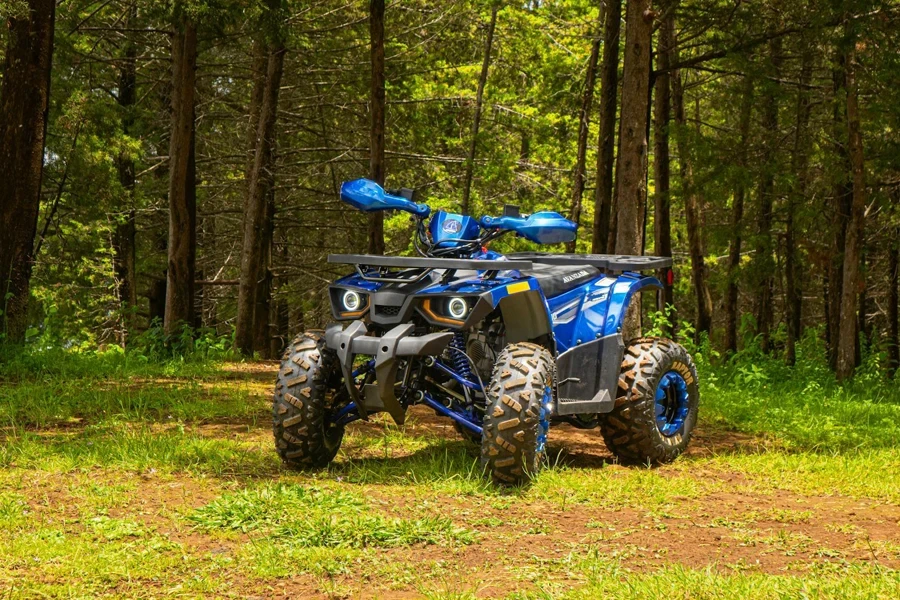Table of Contents
● Introduction
● Market overview
● Different types and their features
● Things to consider when selecting ATVs
● Conclusion
Introduction
ATVs, known for their versatility and popularity, are essential for both recreational and practical applications. These vehicles excel in diverse environments, from rugged trails and forests to farms and work sites. Their design caters to various activities, including trail riding, hunting, farming, and utility tasks. With options ranging from sport to utility models, ATVs provide solutions for riders of all experience levels. Understanding the different types and their features can help in selecting the ideal ATV for specific needs.
Market overview
The ATV market has shown impressive growth and resilience, reflecting its increasing popularity and diverse applications. In 2023, the market size was valued at approximately $3.8 billion, and it is projected to expand significantly over the next several years. This growth is expected to continue at a compound annual growth rate (CAGR) of around 4.5% from 2023 to 2028, according to a report by Grand View Research. Key factors driving this growth include advancements in ATV technology, rising consumer interest in outdoor recreational activities, and the expanding use of ATVs in agricultural and industrial applications. North America currently holds the largest market share, driven by high consumer demand and widespread adoption of advanced ATV technologies. Europe and Asia-Pacific are also significant markets, with Europe expected to show a notable CAGR due to technological advancements and increased consumer spending on recreational activities.
In terms of market segmentation, different types of ATVs cater to specific needs, including sports, utility, youth, and electric models. The market is also segmented by application, such as recreation, agriculture, and military use. Recent trends indicate a growing consumer preference for electric ATVs, driven by environmental concerns and the desire for quieter, low-emission vehicles. Additionally, the integration of advanced features like electronic fuel injection, improved suspension systems, and better safety mechanisms are enhancing ATV performance and rider experience. According to Global Market Insights, the ATV market is expected to achieve a valuation of approximately $5.5 billion by 2031, demonstrating strong and sustained growth across various segments. The increasing adoption of ATVs for both recreational and utilitarian purposes underscores the market’s dynamic nature and its capacity for continued expansion.

Different types and their features
Sport ATVs
Sport ATVs are engineered for speed and agility, making them the top choice for high-adrenaline activities. These ATVs boast powerful engines and advanced suspension systems, allowing for quick acceleration and precise handling. Lightweight frames, responsive brakes, and high ground clearance are standard features, enhancing their performance on rugged terrains at high speeds. Sport ATVs excel in activities such as trail riding and racing, where their design can be fully leveraged. According to Polaris, these models are perfect for enthusiasts seeking thrills in off-road environments. The combination of speed, maneuverability, and durability makes sports ATVs a popular choice for those looking to push their limits in challenging terrains.
Utility ATVs
Utility ATVs are built for versatility and durability, tailored to meet the demands of work-oriented tasks. These ATVs typically feature cargo racks, towing hitches, and robust frames that can handle heavy loads. Designed for applications such as farming, ranching, and general utility work, utility ATVs offer high ground clearance, sturdy suspension systems, and powerful engines to navigate rough terrain while carrying or pulling significant weight. According to Polaris, utility ATVs are essential tools for landowners and professionals who need reliable performance for demanding tasks. Their ability to perform a wide range of functions makes them indispensable in various work settings, from agricultural fields to construction sites.
Youth ATVs
Youth ATVs are specifically designed for younger riders, prioritizing safety and ease of use. These smaller, less powerful models feature engine sizes appropriate for children and teenagers, with key safety features like speed limiters, automatic transmissions, and easy-to-reach controls. Youth ATVs are crafted to introduce young riders to off-roading safely, with lower seat heights and lighter weights ensuring better control. According to ATV.com, these ATVs are crucial for providing a safe and enjoyable off-road experience for younger enthusiasts. They allow children to develop riding skills in a controlled and secure environment, fostering a love for the sport from an early age.
Two-up ATVs
Two-Up ATVs are designed to accommodate two riders, offering additional seating and comfort features. These models include a longer wheelbase, a second seat with a backrest, and extra footrests or floorboards for the passenger. Two-up ATVs maintain the robust performance of single-rider models while ensuring safety and comfort for both riders. They are ideal for couples or friends who enjoy riding together, providing enhanced stability and balanced handling even with two occupants. Sky Powersports Sanford highlights the importance of features like reinforced frames and enhanced suspension systems to ensure a smooth and secure ride for both passengers. These ATVs are perfect for those who want to share their off-road adventures with a companion.
Key features across ATV types
ATVs come equipped with a variety of features designed to enhance performance, safety, and rider comfort across different types. Common features include advanced suspension systems, which provide a smoother ride over rough terrain by absorbing shocks and bumps. Many ATVs also feature powerful engines that offer varying levels of horsepower to suit different activities, from high-speed racing to heavy-duty towing. High ground clearance is another standard feature, allowing ATVs to navigate obstacles and uneven terrain with ease. Safety features such as roll cages, speed limiters, and automatic shut-off systems are increasingly common, enhancing rider protection. Additionally, storage options like cargo racks and under-seat compartments provide practical solutions for carrying gear and supplies, making ATVs versatile for both recreational and utility purposes. These features collectively ensure that ATVs can meet a wide range of needs, from thrilling off-road adventures to demanding work tasks.

Things to consider when selecting ATVs
Rider experience level
Rider experience is a crucial factor in selecting the right ATV, as it influences the choice of model and its features. Beginners should look for ATVs with lower engine power, automatic transmissions, and safety features like speed limiters to ensure a smooth learning curve. These models are typically easier to handle and provide a safer introduction to off-road riding. Intermediate riders who have gained some experience and confidence can opt for ATVs with moderate engine power and more advanced features, such as manual transmissions, for better control and maneuverability. Advanced riders, on the other hand, can handle high-performance ATVs with powerful engines, superior suspension systems, and precise handling capabilities. According to ATV.com, matching the ATV to the rider’s experience level enhances safety and enjoyment, ensuring the best possible riding experience.
Intended use
The intended use of an ATV significantly influences the type of model that should be selected. For recreational purposes, such as trail riding and racing, sport ATVs are the ideal choice due to their speed and agility. They are designed to handle rugged terrains and provide an exhilarating riding experience. For work-related tasks, such as farming, ranching, and land maintenance, utility ATVs are more suitable. These models are built with durability and versatility in mind, featuring cargo racks, towing capabilities, and robust frames to handle heavy loads. Two-up ATVs are perfect for those who enjoy riding with a passenger, offering additional seating and comfort features. According to Sky Powersports Sanford, understanding the specific use case helps in selecting an ATV that meets all functional requirements effectively.
Engine size and power
Engine size and power are critical considerations when choosing an ATV, as they determine the vehicle’s performance and suitability for different riders and uses. Smaller engine sizes, typically up to 70cc, are ideal for young or inexperienced riders, offering manageable power and easier control. Engines ranging from 70cc to 250cc are suitable for beginners to intermediate riders, providing a balance of power and control. More experienced riders often prefer engines above 250cc, which deliver high performance for challenging terrains and demanding tasks. According to Polaris, selecting the right engine size ensures that the ATV meets the rider’s skill level and intended use, whether for leisurely trail rides or heavy-duty work.
Transmission types
The type of transmission in an ATV can significantly impact the riding experience. Automatic transmissions are generally easier to use, making them ideal for beginners and those who prefer a straightforward riding experience. These transmissions handle gear shifts automatically, allowing the rider to focus on steering and navigation. Manual transmissions, on the other hand, provide greater control over the vehicle’s performance, which is beneficial for experienced riders who require precise handling and responsiveness. Manual ATVs typically have a clutch and gear shifter, enabling riders to adjust the power output according to the terrain and riding conditions. According to ATV.com, the choice between automatic and manual transmissions depends on the rider’s experience and the specific demands of their riding activities.

Suspension and handling
Suspension systems play a vital role in the comfort and handling of an ATV, particularly on rough and uneven terrains. Independent rear suspension (IRS) systems are commonly found in modern ATVs, providing a smoother ride by allowing each wheel to move independently. This setup enhances stability and traction, especially on bumpy trails and rocky paths. Solid axle suspensions, while less common, offer better handling in high-speed scenarios and are often preferred in sport ATVs. High-quality suspension systems reduce the impact of shocks and vibrations, improving rider comfort and control. According to Polaris, understanding the benefits of different suspension types helps in choosing an ATV that offers optimal performance for the intended riding conditions.
Conclusion
When selecting an ATV, it is important to thoroughly evaluate specific needs and preferences to ensure the chosen model aligns with the rider’s skill level and intended applications. For beginners, selecting a model with lower engine power and an automatic transmission can offer a safer and more manageable introduction to ATV riding. Intermediate and advanced riders might prefer models with more powerful engines and manual transmissions, providing greater control and enhanced performance. Additionally, considering the intended use of the ATV, whether for recreation, work, or riding with a passenger, can help narrow down the choices. Evaluating safety features, such as roll cages, speed limiters, and automatic shut-off systems, is crucial for ensuring a safe riding experience. Setting a realistic budget and balancing the cost with desired features and performance is also essential. By taking these factors into account, riders can make an informed decision that enhances both performance and enjoyment, leading to a satisfying and fulfilling ATV ownership experience. Careful consideration of these aspects will ensure that the ATV meets the specific requirements and preferences of the rider, providing a reliable and enjoyable vehicle for various applications.




